Joy Neal Kidney's Blog, page 58
January 19, 2022
1955 United Plane Crash near Dexter, Iowa
A United Air Lines two-engine Convair made a forced landing January 19, 1955, in a cornfield south of Dexter, Iowa. Not one of the 36 passengers and crew of three was seriously injured, although the plane was badly damaged.
Parts of the plane were strewn over the mile-long skid in Francis Hochstetler’s field, through a fence, across a road, and through another fence, coming to rest in a field of corn stubble of Fred Lenocker’s.
The plane was over Earlham, enroute from Des Moines to Omaha, when the pilot radioed Des Moines that they were having difficulty controlling the plane and would try to return. Unable to keep the plane high enough, the pilot and copilot made an emergency landing about forty miles from Des Moines. The plane bounced, then another bounce before skidding. Its fuselage split apart at the front of the wings.
The crew–all from Chicago-were pilot Capt. Earl Andreasen, first officer was Tom Boyle, and stewardess Patricia Johnson.
By the time Dexter school bus driver, John Herrick, had finished his route (including his own son Paul, who’d also witnessed the plane going down), he returned to the plane to see if he could help. The passengers (35 men and one woman) and crew were shaken up but okay, so he drove them all into Dexter, to the Dallas County State Bank where Russell Horn, bank manager, and employees served the coffee.
Six passengers had x-rays taken Dexter’s doctors Chapler and Osborn, then most of the were later taken to Des Moines in four ambulances.
 Winterset Madisonian, Jan. 26, 1955
Winterset Madisonian, Jan. 26, 1955 Winterset Madisonian, Jan. 26, 1955
Winterset Madisonian, Jan. 26, 1955How amazing that all 39 people aboard that plane survived the crash landing. Capt. Andreasen and First Officer Boyle were both given $10,000 bonuses for the successful handling of the crippled plane. Stewardess Johnson was given $2500.
Several local people who helped got gifts: cigarette lighters to Doctors Chapler and Osborn, compacts to their nurses, a set of dishes to Lenockers (who served meals to the salvagers), etc.
 Des Moines Tribune, Jan. 31, 1955
Des Moines Tribune, Jan. 31, 1955The United Convair was disassembled, lifted by crane in pieces into trucks, and hauled to the Dexter train station. There they were loaded on flat cars to ship to the Convair plant in San Diego, for repair. The airliner became a cargo plane, flying another 34 years.
 Winterset Madisonian, Feb. 16, 1955
Winterset Madisonian, Feb. 16, 1955Decades later, Brandon Andreasen was looking for information about a crash by a plane his grandfather had piloted in January 1955, and he wanted to visit the site. Tom Fagen, a farm implement dealer in the area, was recommended to Andreasen because Tom is a pilot. He also grew up half a mile from where the plane came to rest, and now lives half a mile in the other direction.
Tom’s wife had even grown up on the farm where the plane hit first, before tearing through fences and across the road to come to a stop in Fred Lenocker’s field. Tom’s inlaws, Hochstetlers, had some old newspaper clippings but hadn’t talked much about it.
Tom loves the history of aircraft and also makes scale models of them. After showing the pilot’s grandson the area of the United Airline Convair crash, he went to work learning as much about the plane and the accident as he could. Besides making a 1/72 scale model of the broken plane in a snowy corn-stubbled field, he has made a 15-minute video about the entire history of the plane, what happened the day of the crash, and even the people involved with it.


Tom Fagen’s inlaws, the Hochstetlers, got a United Airlines check for $25 for the three fences the plane tore out. They still have the uncashed check as a souvenir, plus part of a propeller found in the field that spring.
What caused the plane to crash that winter day? Human error. A Civil Aeronautics Board Investigation found that a fastener on the elevator linkage had been removed the night before during a scheduled airframe inspection, and not reinstalled.
———–
Using today’s rural road names, this happened just southwest of the corner of Cottonwood Avenue and 150th Street in Penn Township, Madison County, Iowa.
Note from Tom Fagen: Andreasen was trained in the Army Air Force and flew the mighty B-29 bomber in WW II. Boyle was younger and graduated from Purdue with an Aeronautical degree before entering his commercial pilot career with United.
Tom Fagen gave a program about the plane crash at Bricker-Price Block in Earlham, November 22, 2019. He brought his diorama of the downed plane, which is usually on loan to the airport at Greenfield.

January 17, 2022
Leora Wilson’s Date Bread Recipe – 1955
Date Bread Best When Served Day Following Baking
“Our guest recipe editor this week is Mrs. Leora Wilson, who with her mother, Mrs. Laura Goff have been residents of Guthrie Center since 1948. Late in 1947 Mrs. Goff of Omaha and her daughter Mrs. Wilson of Perry decided to build a “halfway” house for other members of their families, and chose Guthrie Center as the likely spot for the house, so by February 1948 the house was ready to be occupied.

“Mrs. Wilson, who does most of the cooking in her spacious kitchen, has raised seven children, four of whom still live. Three sons, all air corps officer pilots in World War Two, were killed, namely Dale, killed in the Pacific area; Daniel in the European area, and Clayburn Jur. [sic] in the U.S. in Texas in a plane crash. The other four children, all now with families of their own, include: Mrs. Doris Neal of Dexter, Mrs. Darlene Scar of Earlham, Donald of Washington state, and Delbert of Des Moines.
“The recipe we are using today is a family favorite of the Wilsons, having been served many, many times during the years.”
Date Bread2 1/2 cups white, all purpose flour
2 teaspoons baking powder
1 teaspoon baking soda
1 teaspoon salt
1 cup whole wheat flour
2 cups fresh dates, chopped
1/2 cup walnut meats, chopped
1 egg, well beaten
2 cups sour milk or buttermilk
3 tablespoons melted shortening
Sift together: white flour, baking powder, soda, and salt. Stir in whole wheat flour, dates, and nuts. Combine egg and sour ilk. Add to flour mixture, stirring only 'til well mixed. Add shortening. Turn into a greased loaf pan and bake in a moderate oven (350 degrees) for one hour. Remove from the pan and cool uncovered before storing. Best not used until the next day.
This is an excellent bread for sandwiches or for serving at teas in fancy shapes and cuts.
1955 – The Times, Guthrie Center, Iowa
January 15, 2022
Honor and Respect LLC: a Passion to Serve the People who have Served all of Us
When I noticed a man wearing dark athletic shoes with stars on the back, I asked if there was a story behind the shoes. Yes, and it’s a compelling and far-reaching one!
 The Blue Line shoes
The Blue Line shoesHonor and Respect started in 2018 when current Marion [Iowa] Police Officer and U.S. Air Force veteran Ron Slagle prayed about how he and his family could help first responders and military personnel with the current mental health crisis.
His family got together to design a shoe that would allow others to show their support, and has grown into a something much bigger than themselves.
Mission and Purpose
To let our first responders know that they are not alone, and that we stand with them.
This is bigger than a shoe. It’s a passion to serve the people who have served all of us.
 Honor and Respect LLC is committed to bringing respect to all first responders and military members who devote their lives to helping all of us. When you purchase a pair of Honor and Respect athletic shoes, 100% of profits are donated back to organizations who support our nation’s heroes.
Honor and Respect LLC is committed to bringing respect to all first responders and military members who devote their lives to helping all of us. When you purchase a pair of Honor and Respect athletic shoes, 100% of profits are donated back to organizations who support our nation’s heroes.
We can help first responders by purchasing a pair of Honor and Respect shoes, or other items sold on the Honor and Respect website.

They are currently out of my size in the shoe I want, but I’ve been added to a list to contact when they’re available.
What a great way to support the ones who serve us by wearing something that even starts a conversation about the importance of their jobs.
You may also make donations. Questions? ronslagle@honor-respect.com
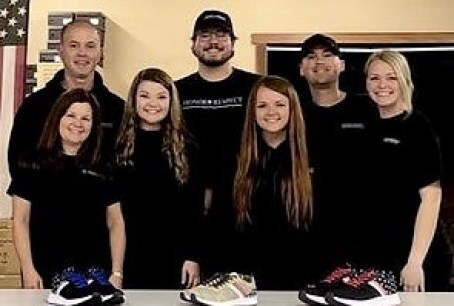 Officer Ron Slagle is in back on the left
Officer Ron Slagle is in back on the left
January 14, 2022
O.S. (Orlando Swain) Neal, born January 14, 1868
O.S. Neal Died Sun., Nov. 4 Following Major Operation
Death Came at Dexter Clinic
O.S. Neal, well known and very highly esteemed Dexter man, passed away Sunday evening at the Dexter Clinic where he was taken following a major operation in the Lutheran hospital in Des Moines. Mr. Neal lived in and near Dexter for many years and will be greatly missed by all who had the pleasure of knowing this fine man.
The service was held in the first Presbyterian church of which he was a member. His pastor, the Rev. S.C. Wadding, officiated and the body rests in the tomb at the Dexter Cemetery. The pall-bearers, all grandsons, were Merritt Neal, Warren D. Neal, Willis K. Neal, Rawson Neal, Clifford Connor, and Mervin Wells.
The music was provided by: Harold Ellis of Redfield, Ed Snydergaard of Dallas Center, and Mrs. Ed Snydergaard as pianist.
—–
Orlando Swain Neal, son of John and Rhoda, was born at Redfield, Iowa, January 14, 1868, and passed away at the Dexter Clinic on November 4, after an illness of six weeks. Although he was of a healthy constitution, he failed to rally after a major operation and answered the Master’s Call at the age of 77 years, 9 months and 21 days.
He was married April 5, 1892, to Nellie Edith Keith of Clay Center, Kansas. Four children came to bless their home: Keith J., Kenneth, and twins: Maurice Marshall, and Mary Marjorie. Keith and Marjorie preceded their father in death.
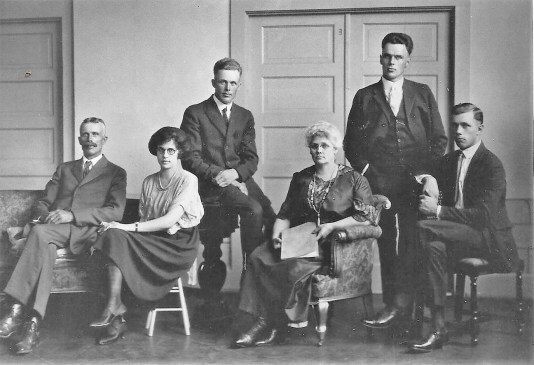 O. Swain, Marjorie, Kenneth, Nellie, Keith, and Maurice (M.M.) Neal
O. Swain, Marjorie, Kenneth, Nellie, Keith, and Maurice (M.M.) NealHe has been a life-time resident of the Dexter community where he was proud to make his home. His home and family were his chief concern and enjoyment; but he was interested also in his friends and the good of the community.
He led a very fruitful life, being active in the Presbyterian church for fifty years and of which had been an elder for many years and was the senior elder of the church at the time of his call to the Heavenly Home.
He evidenced his Christian faith in his life and works and expressed to his family his willingness to respond to the call of his Lord and Savior.
He leaves to mourn his passing his companion and two sons: Kenneth and Maurice both of Dexter. Three sisters also survive: Mrs. Dora Andrew of Des Moines, Mrs. Hannah Doling of Clay Center, Kansas and Ida Andrew of Cordova, Ill. Also twenty grandchildren, five great grandchildren, and a host of nieces and nephews.
The Dexter Sentinel, November 8, 1945
His grandsons had just returned from serving in WWII. Merritt Winsell (Bud) Neal was named for Merritt Winsell, the first Dexter boy killed in WWI.
O.S. Neal was named for two of his mother’s brothers, Orlando and Swain Marshall. (Swain served in the Civil War.)
Neal served on the 1916 Community Building Committee as a representative of the Presbyterian Church. The permanent building was to replace a temporary tabernacle.
When the Dexter Canning Factory was in business, O.S. hired the corn growers and kept an eye on the progress of the crops. He also hired the workers and foremen during canning season.
Swain and Nellie Neal were beloved neighbors of Clabe and Leora Wilson, so they turn up from time to time in Leora’s Dexter Stories: The Scarcity Years of the Great Depression. (Mrs. Neal’s navy beans after the baby twins died, and one time Spats stole Mr. Neal’s mitten!)
January 12, 2022
More Nancy the Horse and Other Stories
Nancy was the landlord’s gentle horse when the Wilson family lived southeast of Dexter. Clabe was a tenant farmer there, where he farmed with horses. They were also allowed to ride Nancy, and she eventually took the “Wilson schoolbus” to the Dexter School 2-3 graveled miles away. Delbert (age 10) drove the horse and buggy, while Donald (9) and Doris (7) rode along.
One day it was icy. Nancy slipped and fell. When she managed to clamber upright again, she hobbled.
The Wilson kids were late for school. Doris cried. The teacher had her sit by the radiator to warm up. The little girl still whimpered when the other kids went out for recess. The teacher put her arm around her. “Doris, are you still cold?”
“No, but Nancy fell down and we might have to shoot her.” More tears.
Well, that’s what her nine-year-old brother announced about Nancy’s predicament.
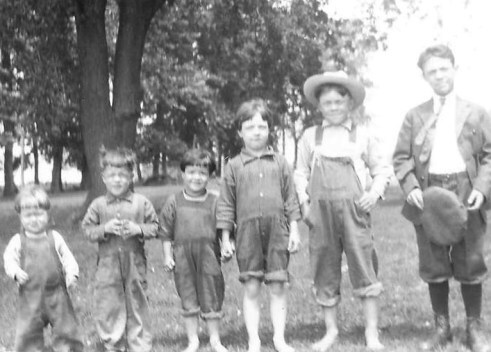 Danny, Dale and Darlene, Doris, Donald, and Delbert Wilson, SW of Dexter, Iowa, about 1925
Danny, Dale and Darlene, Doris, Donald, and Delbert Wilson, SW of Dexter, Iowa, about 1925One day Nancy and and the buggy met a threshing machine on one corner. Nancy trotted right down into the ditch and reared up, with the three kids bouncing around in the buggy. But after they were passed the monster, she pulled them back up on the roadway.
Delbert was told not to drive on the highway because it was gravel. One time they had a different horse, which was faster than Nancy. Delbert headed the horse onto the highway and it was scary for Doris. Yes, she tattled.
Later, someone tattled to the teacher that Doris had said a bad word.
“Doris, what did you say?”
“I don’t know. All I said was ‘I’ll run like the deuce’.” Her brothers talked like that all the time.
“Well, you’re not nice a girl to talk like that. You may sit in the cloak room until recess.”
More tears.
Second grade can be so dramatic, can’t it!
January 10, 2022
The Rock Island Wreck, January 1899
This story is a follow-up to one about the Liza Jane engineer Murray Johnson. (That post includes information about the wreck from the Des Moines Leader.)
This information is from the Atlantic Daily Telegraph, January 11, 1899:
Further details of Disastrous Collision at Chautauqua.
COLWELL’S NECK WAS BROKEN
He Jumped as the Trains Came Together and Died Instantly from the Effects of the Fall.–The Engineer on the Extra Forgot His Orders and Caused the Accident.
The killed in the accident at Chautauqua siding near Council Bluffs yesterday morning about six o’clock are:
J. W. TAYLOR, engineer, Valley Junction. [now West Des Moines]
JOHN STONE, fireman, Centerville.
JOHN COLWELL, fireman, Stuart.
The trains which met in such fatal collision were the regular freight, No. 56, which leaves Council Bluffs for the east every morning at 6 o’clock, and a west bound extra which was running in the opposite direction on No 56’s time. The regular freight was in charge of Conductor H. E. Drew and the crew of the engine, No. 508 consisted of Engineer [Murray] Johnson [sic] and Fireman Colwell. The extra was in charge of Conductor Hanniphan, with Engineer J. W. Taylor and Fireman Stone on its engine, No. 820. No. 56 consisted of sixty cars, mostly empties, while the extra consisted of a train load of steel rails.
All the facts that came to light yesterday seem to indicate that the accident was the result of forgetfulness on the part of one of the engineers. Before leaving Council Bluffs the regular freight had received orders to look out for an extra at Chautauqua siding. Thought it could not be learned definitely, circumstances indicate that the extra was running under orders, general or special, that would require it to make the siding and let the regular train pass. As he drew near the siding Engineer Johnson [sic] of the regular slowed up his train until it was almost at a standstill. The engineer of the extra however, for some cause or other, approached the siding at full speed, apparently without any though of stopping. A curve in the track made it impossible for a sight of the other train to recall to his mind the orders under which he was funning and his train swept down the track upon the unsuspecting train and crew that were helpless to get out of the way even when they discovered their danger.
They struck with a terrible force that jammed the engines into each other until their very cylinder heads met; every particle of woodwork was shivered and torn into splinters and with the projecting iron work, twisted and bent into every imaginable shape, was scattered broadcast.
How the Victims Were Caught.
Of the great danger that impended the engineer and firemen of the regular train had sufficient warning to reverse the engine and jump. To only one, how ever, did the leap prove fortunate; Fireman Colwell escaped death on the engine only to meet it as a result of a terrible fall upon his head, which broke his neck immediately below the base of the brain. But if the engine crew of the extra had any warning of the danger it came too late to enable them to try to save themselves by jumping, and both were crushed within the cab. Fireman Stone was killed instantly, but Engineer Taylor lived for several hours after the time of the collision.
He was badly crushed about the abdomen and lower portious [sic] of the body, but he was conscious and could talk intelligently. Every effort was made to remove him and finally, after several hours of work, the wreckage was lifted from his body. He did not live more than five minutes afterwards, however, his injuries being too great. Before his death Engineer Taylor was heard to remark to those who worked to release him: “It’s my fault; I forgot about the orders.”
Died in the Cab.
Fireman Stone was found wedged in between the cab and tender, one of his hands on the throttle of the engine. He was badly mangled; one side of his head was crushed and his right cheek torn open. His left arm was almost completely cut or torn off and his left thigh was also badly cut and crushed. He death was undoubted instantaneous.
Engineer J. W. Taylor lived in Valley Junction; he was 35 years of age and leaves a wife and one child, a girl 8 years old. Of Fireman John Stone but little could be learned.
The head brakemen of each of the trains escaped death almost miraculously. Brakeman Reynolds of the regular train was standing on the top of the second car from the engine when the train struck. The car ahead of him and the one to the rear were shattered and torn into thousands of pieces but the car on which he stood was torn from its trucks and thrown nearly twenty feet to one side of the track. Reynolds landed with the car and came out of the shower of timber and bolts without injury except for a few bruises.
Brakeman Gould of the extra was in the cab of the engine and the shock of the collision threw him out of the window upon the ground. He was badly shaken up and sustained a fractured collar bone, but otherwise was uninjured. The men in the way-cars were merely shaken up. The bodies were taken east on No. 14 this forenoon, that of Colwell to Stuart and the others to Valley Junction.
—–
Funeral of John Colwell.
Lee Prall went to Stuart this afternoon to help arrange for the funeral of John Colwell. The body will be brought here and the funeral held at the Congregational church immediately after the arrival of No. 5, due here at 11:07.
—–
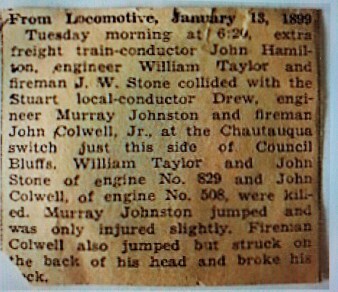 Stuart Locomotive, January 13, 1899
Stuart Locomotive, January 13, 1899Murray Johnston became the engineer on the Liza Jane, which was the branch train from Stuart/Menlo to Guthrie Center. His last run was in 1912.
I thought of the train as a safer way to travel than a horse and wagon, but I’d heard of the deliberate smashing of engines as a stunt at the Iowa State Fair, with the engineers bailing before the head-on crash!
January 7, 2022
Clabe Wilson, born January 7, 1888
My Grandpa Clabe Wilson was born January 7, 1888. I sure wish I remembered him.
Mom and I lived with Grandma and Grandma at Minburn my first two months. I was a toddler when we lived at the Perry acreage when families couldn’t be where Dad was stationed. I was two years old when Grandpa Clabe died.
Clabe D. Wilson Laid to Rest
Once Lived Near Dexter
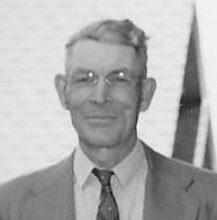 Funeral services were held Oct. 9 for Claiborne (Clabe) D. Wilson, former Dexter resident at the Workman Funeral home in Perry.
Funeral services were held Oct. 9 for Claiborne (Clabe) D. Wilson, former Dexter resident at the Workman Funeral home in Perry.
The Rev. Lyle V. Newman of the First Christian Church officiated and burial was in the Violet Hill cemetery.
Music was furnished by Mrs. John Canutt and Mrs. Galen Fiscel, accompanied by Mrs. Charles Cornelius. Songs included “No Night There” and “God Will Take Care of You.”
Casket bearers were Lester Crumley, Roy Snyder, Everett Shaw, and Carl Reeves of Minburn, and Kenneth Neal and Pete [Jensen] of Dexter.
Obituary
Claiborne Daniel Wilson, 58, died Saturday, October 5, 1946, at his home two miles southeast of Perry. He had suffered a general breakdown in health.
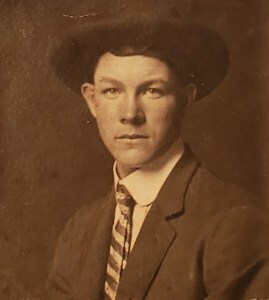 Clabe Wilson, about 19002
Clabe Wilson, about 19002He was born January 7, 1888, near Coon Rapids in Carroll county, the son of Georgia Ann and Daniel Ross Wilson.
During his lifetime he farmed in various localities including Guthrie Center, Stuart, Dexter, and Minburn. He moved to his present home about two years ago. The family lived near Dexter nearly 20 years, leaving there about 8 years ago.
 Clabe Wilson married Leora Goff February 15, 1914, at Wichita, Iowa
Clabe Wilson married Leora Goff February 15, 1914, at Wichita, IowaOn February 15, 1914, he was married to [Leora] Frances Goff, who survives. Also living are two sons, Delbert G. of Perry and Donald W., who is in the Navy, two daughters, Mrs. Warren D. Neal of Redfield and Mrs. Alvin C. Scar of Earlham; six grandchildren, a half-brother, Fred Davis of Des Moines, three sisters, Mrs. Alice McLuen of Stuart, Mrs. Fonnie [Kiggens] of Boston, Mass., and Mrs. Verna Parrott of Des Moines, and several nieces and nephews.
Preceding him in death were three sons, Dale R., Daniel S. and Claiborne [Junior], and three children who died in infancy.
[Local newspaper] October 17, 1946
Clabe Wilson had had a stroke the month before, but was home. Mom made the comment that he died of a stroke and a broken heart. Dale, Danny, and Junior lost their lives between the end of 1943 and 1945. The terrible news about two of them arrived in early 1946.
January 5, 2022
Nancy and the “Wilson Schoolbus”
In the mid-1920s, the Wilson’s landlord not only attended the Presbyterian Church, which he lived near, his house and barn were near the Dexter school.
 Delbert and Donald, just arrived home from school. Donald’s 7th birthday, September 14, 1923, SE of Dexter, Iowa.
Delbert and Donald, just arrived home from school. Donald’s 7th birthday, September 14, 1923, SE of Dexter, Iowa.The landlord allowed the Wilsons to use the “nice gentle pony” Nancy. Oldest sons Delbert and Donald rode Nancy not quite 3 miles to school, leaving the horse in the landlord’s barn all day.
Kids were given authority a lot younger in those days, at least rural ones.
Decades later, Leora Wilson wrote in her memoirs, “They did pretty good, even did grocery shopping. I would send a list of groceries to get when they left for school and they would get the groceries after school. Clabe, their father, fixed a grain sack with a draw-string to hang over the saddle horn. Once they came home and no sack of groceries. They went back and someone had picked the sack of groceries up and hung it on a fencepost–all the groceries were there.”
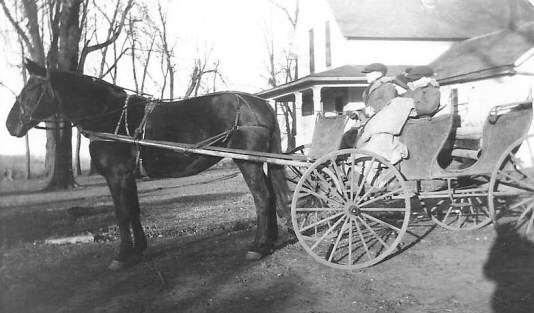 Nancy ready to give Delbert, Doris, and Donald a ride to school in the “Wilson school bus.”
Nancy ready to give Delbert, Doris, and Donald a ride to school in the “Wilson school bus.”When Doris started school in 1924, Clabe taught Delbert to hitch Nancy to a rig and drive the “Wilson school bus” to town. He was 9 years old.
While they lived on this farm, Leora ordered a sewing machine from the Sears Roebuck catalogue. It was too large to carry with the rural mail delivery, so the postman left a note to pick it up the post office. As soon as the kids got home from school, Leora drove Nancy and the rig back to town for her treasure.
It looks like the younger Wilson kids also got to enjoy this gentle horse.
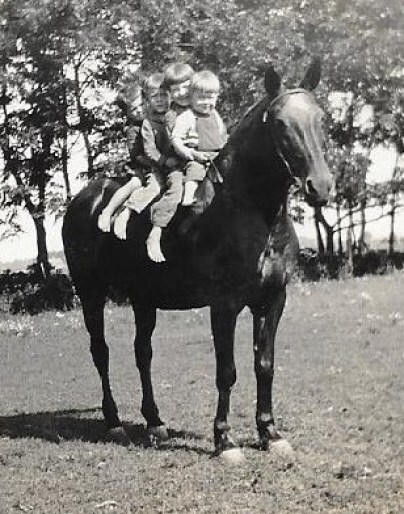 Alas, there’s no date. Darlene, Dale, Doris, and Danny Wilson.
Alas, there’s no date. Darlene, Dale, Doris, and Danny Wilson.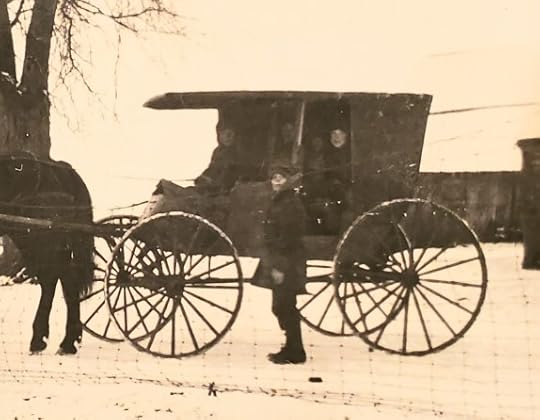 In November 1926, five siblings rode this “Wilson bus” to school.
In November 1926, five siblings rode this “Wilson bus” to school.Doris noted that sometimes when just the three kids rode, the wind blew so hard she couldn’t get her breath. When it rained, their mother sent an oil cloth to hold over themselves. When Dale and Darlene started school in 1926, Clabe made a cover for a two-seater buggy so all five could ride to town and back.
January 3, 2022
Ether
Ether was commonly used as an anesthetic for more than a century. Some of us are old enough that we can attest that it worked well!
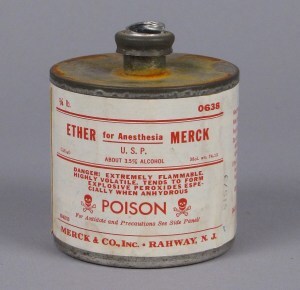
Doctors the births of ten Wilson children (two sets of twins), in rural Guthrie County, Stuart, and Dexter. Leora’s mother was also with her each time, from 1915 to 1931. Among other things, the babys’ grandmother “administered the ether.” She dripped the liquid anesthetic onto a cloth for Leora to breathe.
Doctor Keith Chapler, who arrived in Dexter in 1933, also used it for Leora when he fished the broken needle out of her hand in early 1935. The ether used as an anesthetic made her nauseous afterwards. Since it was terribly cold that January, the doctor was also concerned that breathing ether could make her more susceptible to pneumonia.
A Little History
What is ether? An inhalation anesthetic, which was used for over a hundred years. Its discovery as an anesthetic didn’t occur until 1840s, marking the birth of a modern age in anesthesiology. Before the middle of the 19th century and the discovery of ether, surgery was a rare and gruesome procedure.
Ether was safe, easy to use, and was the standard general anesthetic until the 1960s when the fluorinated hydrocarbons came into common use. Although they reduced ether’s problems of nausea and flammability, they were expensive to produce and brought their own side effects. The open-drop delivery system for ether was traded for vaporizers and monitoring systems.
1950s

Doctor Chapler used ether when my sister Gloria, cousin Susan, and I underwent tonsillectomies in December of 1950. I don’t remember the smell, but that it put me out quickly.
The clipping says that Susan’s mother, Mrs. John Shepherd, had an 8-pound baby at the Dexter hospital about the same time!
Aunt Nadine Shepherd was probably administered ether during the birth. I’m pretty sure they gave my mother some when I was born in 1944.
Use During the Civil War
I remembered that the protagonist in one of Jocelyn Green’s historical novels about the Civil War was a nurse, and that she wrote very descriptive medical scenes. Jocelyn enjoys research, so I figured she’d probably studied ether. Indeed, ether and chloroform, both of which were used as an anesthesia. She shared what she’d learned, along with sources.
(Wedded to War is the first of Jocelyn’s fascinating “Heroines Behind the Lines” series.)
Ether was less dangerous than chloroform, took effect more slowly with fewer side effects, but patients objected to the odor, which could trigger coughing.
December 31, 2021
A Child’s 100-Year-Old Bentwood Chair from Sunday School
When the Dexter Presbyterian Church decided to sell some of the older items from the basement, my mother wanted to buy one of the small chairs. Someone asked her why, since she didn’t even have any grandchildren.
Well, Mom (Doris) had some history with those small chairs. When the Wilson family first moved to the Dexter area, her father Clabe was a tenant farmer southeast of town. The owner not only attended the Presbyterian Church, he lived near the church.
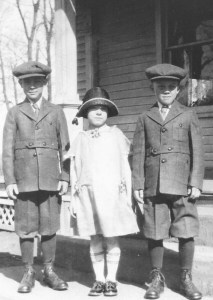 At least the three oldest Wilson children attended Sunday School at the Dexter Presbyterian Church. Here they are, dressed up on Easter 1925, ready to go to Sunday School. (Doris is wearing the green pongee dress her mother made.)
At least the three oldest Wilson children attended Sunday School at the Dexter Presbyterian Church. Here they are, dressed up on Easter 1925, ready to go to Sunday School. (Doris is wearing the green pongee dress her mother made.)
So, these three Wilson kids sat on those little chairs during the 1920s.
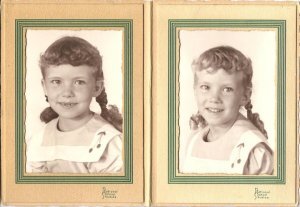 Doris’s own daughters (Joy and Gloria) attended the same Sunday School with their Neal cousins during the late 1940s and 1950s. One of her daughters (Joy) became the mother of Doris’s only grandchild, whose own small daughter (Kate, age 4 1/2) will enjoy owning the heirloom chair, I hope, especially because of the stories that come with it.
Doris’s own daughters (Joy and Gloria) attended the same Sunday School with their Neal cousins during the late 1940s and 1950s. One of her daughters (Joy) became the mother of Doris’s only grandchild, whose own small daughter (Kate, age 4 1/2) will enjoy owning the heirloom chair, I hope, especially because of the stories that come with it.
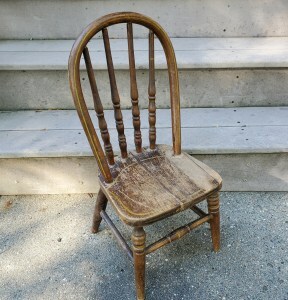
The only thing better than an heirloom is an heirloom with a story!



